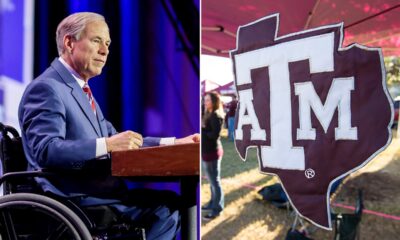Politics
Americans believe US should focus more on domestic issues, but support leadership on world stage: poll

A majority of Americans believe the U.S. should focus more on issues at home and withdraw from foreign affairs, despite an increasing number of Americans believing the U.S. should be more engaged and take the lead when it comes to international events.
Just under two-thirds of Americans, 62%, believe the U.S. would be “better served by withdrawing from international affairs and focusing more attention on problems here at home,” according to the results of the Ronald Reagan Institute’s 2024 summer survey, which was shared exclusively with Fox News Sunday.
Despite that finding, the percentage of Americans who believe it’s important for the U.S. to be more engaged and take the lead in international events is on the rise, up 12 points in the last six months.
A majority, 54%, expressed support for a more engaged U.S. foreign policy, up from 42% in November. The latest figure includes 66% of Democrats and 49% of Republicans.
ZELENSKYY APPEALS FOR AID, INVESTMENT IN ENERGY SECTOR AT UKRAINE RECOVERY CONFERENCE IN BERLIN
Ukrainian servicemen search a target with a U.S. Stinger air defense missile launcher on the front line in Zaporizhzhia region, Ukraine, on May 28, 2024. (AP Photo/Andriy Andriyenko)
“From this year’s Reagan Institute summer survey, we’re seeing an uptick in the numbers of Americans who really want to see and are seeking policies that reflect American leadership in the world, that reflects President Reagan’s principles of leadership, of strength on the global stage when it comes to the chaos and conflict that we’re seeing around the world,” Rachel Hoff, the policy director at the Ronald Reagan Institute, told Fox News Digital.
“The number of Americans seeking American leadership and engagement is at a five-year high,” she added.
Most Americans also said they believe U.S. involvement in international events is beneficial for both the United States (57%) and the world (61%).
Over three-fourths, 78%, of respondents indicated they agree that U.S. leadership and engagement in international affairs is “essential” for boosting the economy and securing favorable trade arrangements.
A similar amount of Americans, 77%, indicated they believe it is important for the U.S. to stand up for human rights and democracy around the world, while 86% indicated it was important for the U.S. to maintain a strong military that can maintain peace and prosperity both at home and around the world.
The poll comes amid continued debate over how involved the U.S. should be in defending Ukraine amid its war with Russia, with some arguing that the billions of dollars spent equipping the Ukrainian military would be better spent on domestic issues.
Down two percent since the same Reagan Institute survey last summer, 57% of Americans said they support sending military aid to Ukraine, compared to 32% who oppose it. Another 11% indicated they were unsure.
Americans also believe it is in the best interest of the U.S. that Ukraine win its conflict against Russia, with 75% saying it is important Ukraine win compared to 17% who indicated it was unimportant. There was no change in those percentages compared to last year’s survey.
Hoffman said the Reagan Institute’s data on Ukraine has stayed “remarkably consistent over time.”
“So we started asking questions about Ukraine, about American support and military aid for Ukraine’s efforts in their war against the Russian invasion, and those numbers have not shifted at all since 2022,” she said.
“Even with all the debate and discussion that we’re seeing in the media and on Capitol Hill about aid to Ukraine and the really important conversations that policy leaders are having, it’s really important to remember and recognize that the American people, in the middle of all those conversations, have made clear that they want to continue supporting America’s allies and our friends around the world that are standing up against aggression… and they want to do that by sending U.S. military aid to Ukraine.”
ISRAELI-DEPLOYED AI IN GAZA LIKELY HELPS IDF REDUCE CIVILIAN CASUALTIES, EXPERT SAYS

An Israeli soldier attaches an Israeli flag on top of an armored personnel carrier (APC) near Israel’s border with Gaza on April 15, 2024.
The survey also found that Americans believe Israel — a war-torn country that responded forcefully to the October 7, 2023, invasion by Hamas militants — should be supported by the U.S.
“Both Republicans and Democrats, in large numbers, want to support Israel in its fight against the Hamas terrorists in the Middle East,” Hoff said.
A majority of Americans, 56%, said they support sending aid to Israel, compared to 35% who said they oppose the effort. Another 68% said they support the U.S. sending missile defense systems to Israel to “help it defend against” drone or missile attacks.
“I think the more we drill down into what the American people want our government to be doing to support our allies and friends around the world, to push back on tyranny and terrorism and to support those fighting for freedom and democracy, those numbers only rise,” Hoff said.
Fifty-five percent of those surveyed also said they would support an Israeli counterattack against continued Iranian aggression, while 31% said they would oppose it.
Three-quarters of Americans, 75%, said they were concerned about humanitarian conditions in Gaza.
Seventy-four percent said they believe Israel’s war with Hamas matters to U.S. security and prosperity, compared to 73% who said the same for Ukraine’s war with Russia.
Americans also indicated concern over Chinese military build-up, with 82% saying they are “extremely” or “somewhat” concerned.
Other findings related to China included concern over the communist nation’s human rights violations (83%), technology theft (83%), overtaking the U.S. as the world’s superpower (75%), and the isolation of Taiwan (68%).
Based off previous Reagan Institute surveys, Hoff said public opinion on China “has been moving and shifting significantly over time” and that there’s an increasing number of Americans who are “seeing China as an adversary.”
“They’re concerned about, technology theft, economic practices, human rights abuses, abuses of the Chinese Communist Party, and they’re concerned about the Chinese military buildup,” she said.

President Biden meets with Chinese President Xi Jinping on the sidelines of the G20 leaders’ summit in Bali, Indonesia, November 14, 2022. (REUTERS/Kevin Lamarque/File Photo)
A slim majority, 51%, said they believe the social media app TikTok, which is owned by a Chinese company that is closely connected to the Chinese government, should be banned in the U.S. Another 39% percent said they oppose a ban of the app, while 10% said they were unsure.
The survey, which was conducted from May 20 to May 27, sampled 1,257 U.S. adults.

Politics
Video: Pete Hegseth’s Confirmation Hearing

In a hearing that stretched more than four hours, Democrats pressed Pete Hegseth, President-elect Donald J. Trump’s pick for defense secretary, on numerous allegations of misconduct, his views about women in combat and his ability to lead the department. Eric Schmitt, national security correspondent for The New York Times, explains a moment that stood out in the hearing.
Politics
Trump Energy Sec pick to share American 'energy dominance' vision at confirmation hearing: 'Agent for change'

Chris Wright, President-elect Trump’s nominee to lead the U.S. Department of Energy, is planning to tell senators in charge of his confirmation that he will focus on restoring American “energy dominance” at home and abroad.
Wright, a fossil fuel executive who in the past has been critical of the media blaming climate change for repeated wildfires, is expected to deliver his opening statement before the Senate Energy and Natural Resources Committee on Wednesday morning. Fox News Digital obtained a copy of the statement in advance ahead of the hearing scheduled to start at 10 a.m. ET.
“I am humbled by the great responsibility this position holds,” Wright is expected to say in his opening statement. “America has a historic opportunity to secure our energy systems, deliver leadership in scientific and technological innovation, steward our weapons stockpiles, and meet Cold War legacy waste commitments.”
Describing himself as a “science geek, turned tech nerd, turned lifelong energy entrepreneur,” Wright will tell the committee how his “fascination with energy started at a young age in Denver, Colorado.” His opening statement discusses how he enrolled at MIT “specifically to work on fusion energy” and later started graduate school at the University of California at Berkeley where he worked “on solar energy as well as power electronics.”
TRUMP EYES AN END TO NEW WINDMILL PRODUCTION UNDER SECOND TERM, SAYS THEY ARE ‘DRIVING THE WHALES CRAZY’
Liberty Oilfield Services Inc. CEO Chris Wright laughs as he celebrates the companies IPO on the floor of the New York Stock Exchange, January 12, 2018. (Reuters)
“Energy is the essential agent of change that enables everything that we do. A low energy society is poor. A highly energized society can bring health, wealth, and opportunity for all,” Wright will say. “The stated mission of the company that I founded – Liberty Energy – is to better human lives through energy. Liberty works directly in oil, natural gas, next generation geothermal and has partnerships in next-generation nuclear energy and new battery technology.”
“Energy has been a lifelong passion of mine, and I have never been shy about that fact,” Wright plans to tell the committee. “Then again, I have never been shy about much. President Trump shares my passion for energy and, if confirmed, I will work tirelessly to implement his bold agenda as an unabashed steward for all sources of affordable, reliable and secure American energy.”
On Tuesday, committee Democrats led by Sen. Martin Heinrich of New Mexico called for Wright’s confirmation hearing to be delayed by at least a week, citing how they had not yet received “the standard financial disclosure report, ethics agreement, or the opinions from the designated agency ethics officer and the Office of Government Ethics stating that the nominee is in compliance with the ethics laws.”
Chairman Mike Lee, R-Utah, has already pushed back the confirmation hearing for Doug Burgum, Trump’s pick for interior secretary, by two days until Thursday due to an OGE paperwork delay, but Wright’s remained on the schedule Wednesday.

Liberty Oilfield Services CEO Chris Wright at Liberty January 17, 2018. (Andy Cross/The Denver Post via Getty Images)
If approved as secretary, Wright would manage energy policy and production in the United States, as well as the nation’s nuclear weapon stockpile. He would also work with Burgum on the National Energy Council, where they would develop Trump’s energy dominance policy involving increased production of U.S. oil and gas.
Wright has indicated that he plans to resign as CEO and chairman of his fracking company, Liberty Energy, if approved.
DEMS BLAME LA FIRE ON ‘CLIMATE CHANGE’ DESPITE CITY CUTTING FIRE DEPARTMENT BUDGET

Trump’s nominee to be Secretary of the Interior Doug Burgum rides an elevator in the Dirksen Senate Office Building on Dec. 10, 2024 in Washington, DC. (Anna Moneymaker/Getty Images)
In his opening statement, Wright identifies three “immediate” tasks that he would focus his attention on if confirmed.
“The first is to unleash American energy at home and abroad to restore energy dominance,” Wright will say. “The security of our nation begins with energy. Previous administrations have viewed energy as a liability instead of the immense national asset that it is. To compete globally, we must expand energy production, including commercial nuclear and liquified natural gas, and cut the cost of energy.”
“Second, we must lead the world in innovation and technology breakthroughs,” the statement continues. “Throughout my lifetime, technology and innovation have immeasurably enhanced the human condition. We must protect and accelerate the work of the Department’s national laboratory network to secure America’s competitive edge and its security. I commit to working with Congress on the important missions of the national laboratories.”
“Third, we must build things in America again and remove barriers to progress,” Wright will say. “Federal policies today make it too easy to stop projects and very hard to start and complete projects. This makes energy more expensive and less reliable. President Trump is committed to lowering energy costs and to do so, we must prioritize cutting red tape, enabling private sector investments, and building the infrastructure we need to make energy more affordable for families and businesses.”
Politics
Column: He lost everything in a wildfire. Here's one city councilman's practical advice

SANTA ROSA, Calif. — Jeff Okrepkie wants to make one thing perfectly clear.
Yes, his home burned to the ground after he fled a galloping wall of flames with his wife, their toddler, two dogs and the few items they managed to cram into their cars. But no, Okrepkie insisted, he is not a fire victim.
“I’m a survivor,” he said. “It seems kind of ticky-tacky, but it helps with my mental state to think of myself that way … I survived something that many people haven’t.”
Okrepkie and his wife lost their home and virtually everything they owned in the 2017 Tubbs fire, which turned a wide swath of the Wine Country — including Santa Rosa’s middle-class Coffey Park neighborhood — into a heap of cinder and ash. At the time, it was the most destructive wildfire in California history. Soon, it may rank a mere third, with the still-blazing Los Angeles County inferno topping the list.
Okrepkie, 45, a commercial real estate agent, was displaced through ill fortune. He was elected years later to the Santa Rosa City Council by popular vote. He became an advocate for wildfire survivors, their champion and a clearinghouse of recovery tips by choice and his lived experience.
“How can you have all this information and not share it?” he said during a conversation this week a few blocks from City Hall and a short drive from the subdivision where he returned nearly 2½ years after fire chased him out. “It’s almost seems selfish not to.”
The October weekend that forever changed Okrepkie’s life began in what now seems like blessed normalcy.
He and his wife, Stephanie, attended a wedding on Saturday, a welcome bit of alone time in adult company. Their son was nearly 2 years old and had lately “started scaling the walls,” so Sunday was spent converting his crib into “a big-boy bed.” After it was made up, Okrelie took a picture because they were all so excited.
The rest transpired in a flash.
Reports of a fire breaking out in Napa, 40 miles away. His wife nodding off in front of the TV news. Okrepkie falling asleep. His sister calling and waking him with word of another fire, in Calistoga, 16 miles distant and spreading on powerful winds.
Not much later, the flames leapt Highway 101 and its six lanes and bore down on Coffey Park. Stephanie Okrepkie drove away with her son, the family’s black Lab mix and their Cavalier King Charles Spaniel. Jeff stayed behind, grabbing what he could, until a giant ember landed at his feet, spitting sparks. He took off.

Santa Rosa City Councilman Jeff Okrepkie
(Mark Z. Barabak)
He dispenses his wildfire wisdom in two parts, before and after disaster strikes.
Okrepkie suggested starting with a list of things to grab before you’re forced to go. Figure out what you can get your hands on in five minutes or less and start there, beginning with “the things that are crucial to your life” — passports, birth certificates, marriage certificates, insurance policies, wills, trusts. Expand the list to items you can conceivably gather in 10, 15 and 30 minutes.
Focus, Okrepkie said, on things that are irreplaceable — “an urn with your parents remains, wedding rings” — or that have sentimental value. Clothes, shoes, underwear, pet food; those types of things can be purchased later.
Okrepkie particularly regrets leaving behind a photo of his grandparents, which his late grandmother carried with her everywhere. His wife lost the military fatigues her father wore when he was killed in Iraq, though the couple recovered his dog tags and “challenge coin.”
If you lose your home, Okrepkie went on, don’t wait to find temporary housing. “As soon as you get stabilized somewhere,” he advised, “start calling apartments.” And if it’s unfurnished, make do with used or donated items. “When you get back into your house,” Okrepke said, “that’s when you start spending on the dining room table … that looks nice in your home.”
Beyond that, he counseled patience.
Take as much time as you need to catalog your losses for insurance purposes. If you can collect, say, up to $700,000 and devote 10 hours to compiling a thorough list, that works out to $70,000-an-hour. “That’s a pretty well-paying job,” Okrepkie said. “Think of it that way.”
Also, he said, carefully document every interaction with your insurance company. You’re likely to deal with a number of adjusters, some of whom will move on before your claim is settled. It’s important to have written proof of what was said or promised, so you don’t have to start each time with someone new.
When it comes to rebuilding — if that’s your plan — don’t hurry. Yes, Okrepkie said, there’s an understandable urge to return home as quickly as possible. But he warned against making decisions in haste — in part because rules and regulations can change, affecting what and how you’re able to rebuild. “If you’re rushing, you could be doing something to fit into a box that all of a sudden just became bigger three weeks later.”
He was glad he purchased his new home from a “mass builder” — a developer that goes through the permitting and legal process, then offers buyers a range of floor plans and options — rather than going it alone with an individual architect and builder.
“Most people have never built a house,” Okrepkie said. “They just bought a house that already exists. And so they don’t know what goes together” — carpets, countertops, cabinets, tiles and on. “Whereas these guys were like, ‘Yep, we have this and this and this and this and this.’ It’s a lot easier to comprehend when you have limited choices.”
Through it all, Okrepkie said, building and nurturing a sense of community was vital.
“I can sit here and tell you my entire fire story,” he said over lunch at a cantina in downtown Santa Rosa, “and you’ll empathize with it.” But even the most caring and compassionate person can’t relate “in the same way as someone who’s going through what you’re going though.”
A friend started a gathering that jokingly came to be called “Whine Wednesdays,” where survivors got together — at first on camping chairs set amid the ruins — to drink beer and wine “and just talk to each other,” Okrepkie said. “Not bitching and complaining. Just having conversations.”
His activism on behalf of the burned-out neighborhood led to a seat on the city Planning Commission, which in turn led to Okrepkie’s election in 2022 to the Santa Rosa City Council.
As someone with experience on both sides of disaster — as a wildfire survivor as well as a government official dealing with its aftermath — he offered several suggestions for those in public office.
“Be careful with your messaging, because people can take things very personally,” Okrepkie said. “Don’t call people homeless … We have a home. It burnt.”
Be patient. Very patient. Even as months and years pass and the initial trauma has faded, you’re facing people still grappling with perhaps the worst experience of their life. “Be careful about being too dismissive,” Okrepie said, or coming across as unfeeling.
Don’t be afraid to act boldly if your action can hasten the recovery, he continued. “With electeds there’s always a fear of, ‘Am I going to piss off too many people?’ I don’t think there’s a more altruistic thing you can do than put your neck on the line for people that lost everything.”
Not least, don’t treat survivors as though they’re seeking anything more than they had before.
“We’re not asking to build mansions,” Okrepkie said over his taco salad. “If you have a car you really like and someone hits it, you’re not going to be like, ‘I want a Maserati.’ Just give me what I had … I’m not trying to game the system. There always bad apples that will try to. But most are good people in a crap situation.”
It’s pretty straightforward, he suggested. Be caring. Be kind.
-

 Health1 week ago
Health1 week agoOzempic ‘microdosing’ is the new weight-loss trend: Should you try it?
-
/cdn.vox-cdn.com/uploads/chorus_asset/file/25822586/STK169_ZUCKERBERG_MAGA_STKS491_CVIRGINIA_A.jpg)
/cdn.vox-cdn.com/uploads/chorus_asset/file/25822586/STK169_ZUCKERBERG_MAGA_STKS491_CVIRGINIA_A.jpg) Technology6 days ago
Technology6 days agoMeta is highlighting a splintering global approach to online speech
-

 Science4 days ago
Science4 days agoMetro will offer free rides in L.A. through Sunday due to fires
-
/cdn.vox-cdn.com/uploads/chorus_asset/file/25821992/videoframe_720397.png)
/cdn.vox-cdn.com/uploads/chorus_asset/file/25821992/videoframe_720397.png) Technology1 week ago
Technology1 week agoLas Vegas police release ChatGPT logs from the suspect in the Cybertruck explosion
-

 Movie Reviews1 week ago
Movie Reviews1 week ago‘How to Make Millions Before Grandma Dies’ Review: Thai Oscar Entry Is a Disarmingly Sentimental Tear-Jerker
-

 Health1 week ago
Health1 week agoMichael J. Fox honored with Presidential Medal of Freedom for Parkinson’s research efforts
-

 Movie Reviews1 week ago
Movie Reviews1 week agoMovie Review: Millennials try to buy-in or opt-out of the “American Meltdown”
-

 News1 week ago
News1 week agoPhotos: Pacific Palisades Wildfire Engulfs Homes in an L.A. Neighborhood

















